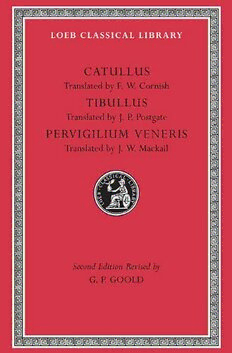Download Catullus. Tibullus. Pervigilium Veneris. PDF Free - Full Version
Download Catullus. Tibullus. Pervigilium Veneris. by G. P. Goold in PDF format completely FREE. No registration required, no payment needed. Get instant access to this valuable resource on PDFdrive.to!
About Catullus. Tibullus. Pervigilium Veneris.
Catullus (Gaius Valerius, 84–54 BCE), of Verona, went early to Rome, where he associated not only with other literary men from Cisalpine Gaul but also with Cicero and Hortensius. His surviving poems consist of nearly sixty short lyrics, eight longer poems in various metres, and almost fifty epigrams. All exemplify a strict technique of studied composition inherited from early Greek lyric and the poets of Alexandria. In his work we can trace his unhappy love for a woman he calls Lesbia; the death of his brother; his visits to Bithynia; and his emotional friendships and enmities at Rome. For consummate poetic artistry coupled with intensity of feeling Catullus's poems have no rival in Latin literature. Tibullus (Albius, ca. 54–19 BCE), of equestrian rank and a friend of Horace, enjoyed the patronage of Marcus Valerius Messalla Corvinus, whom he several times apostrophizes. Three books of elegies have come down to us under his name, of which only the first two are authentic. Book 1 mostly proclaims his love for 'Delia', Book 2 his passion for 'Nemesis'. The third book consists of a miscellany of poems from the archives of Messalla; it is very doubtful whether any come from the pen of Tibullus himself. But a special interest attaches to a group of them which concern a girl called Sulpicia: some of the poems are written by her lover Cerinthus, while others purport to be her own composition. The Pervigilium Veneris, a poem of not quite a hundred lines celebrating a spring festival in honour of the goddess of love, is remarkable both for its beauty and as the first clear note of romanticism which transformed classical into medieval literature. The manuscripts give no clue to its author, but recent scholarship has made a strong case for attributing it to the early fourth-century poet Tiberianus.
Detailed Information
| Author: | G. P. Goold |
|---|---|
| Publication Year: | 1921 |
| ISBN: | 9780674990586 |
| Pages: | 396 |
| Language: | Latin |
| File Size: | 16.835 |
| Format: | |
| Price: | FREE |
Safe & Secure Download - No registration required
Why Choose PDFdrive for Your Free Catullus. Tibullus. Pervigilium Veneris. Download?
- 100% Free: No hidden fees or subscriptions required for one book every day.
- No Registration: Immediate access is available without creating accounts for one book every day.
- Safe and Secure: Clean downloads without malware or viruses
- Multiple Formats: PDF, MOBI, Mpub,... optimized for all devices
- Educational Resource: Supporting knowledge sharing and learning
Frequently Asked Questions
Is it really free to download Catullus. Tibullus. Pervigilium Veneris. PDF?
Yes, on https://PDFdrive.to you can download Catullus. Tibullus. Pervigilium Veneris. by G. P. Goold completely free. We don't require any payment, subscription, or registration to access this PDF file. For 3 books every day.
How can I read Catullus. Tibullus. Pervigilium Veneris. on my mobile device?
After downloading Catullus. Tibullus. Pervigilium Veneris. PDF, you can open it with any PDF reader app on your phone or tablet. We recommend using Adobe Acrobat Reader, Apple Books, or Google Play Books for the best reading experience.
Is this the full version of Catullus. Tibullus. Pervigilium Veneris.?
Yes, this is the complete PDF version of Catullus. Tibullus. Pervigilium Veneris. by G. P. Goold. You will be able to read the entire content as in the printed version without missing any pages.
Is it legal to download Catullus. Tibullus. Pervigilium Veneris. PDF for free?
https://PDFdrive.to provides links to free educational resources available online. We do not store any files on our servers. Please be aware of copyright laws in your country before downloading.
The materials shared are intended for research, educational, and personal use in accordance with fair use principles.

